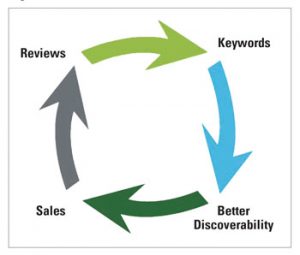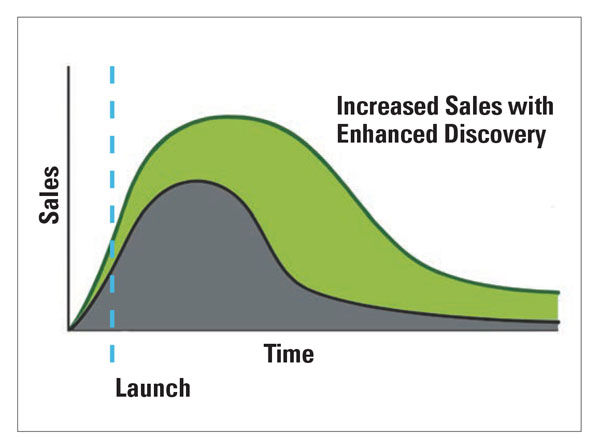PUBLISHED SEPTEMBER 2017
by Joshua Tallent, Firebrand Technologies, and Chris Sim, Kadaxis -

Joshua Tallent

Chris SIm
Two case studies on how keywords and reviews impact book sales.
As you have probably heard, a book’s metadata has a tremendous impact on how well it sells. Studies have shown that books with the most essential metadata elements have average sales 75 percent higher than those without, and that novels (specifically) with these essential metadata elements have average sales 170 percent higher than those without.
Beyond basic metadata, though, publishers of all sizes are constantly on the lookout for effective strategies to increase the discoverability and sales of their titles on the major online retailers.
The Firebrand Research Labs team, in partnership with Kadaxis and NetGalley, has undertaken two studies over the past year that look closely at how publishers can increase discoverability and encourage more book sales. In this article, we’d like to talk about those two projects, and give you some insights into how you can implement these strategies yourself.
Keywords Are Key

Firebrand Technologies and Kadaxis conducted a research project released in January 2017 to study the impact of keywords on book sales. The hypothesis of the project was that by analyzing the natural language readers use to describe books online, we could curate keywords to increase search visibility, improve discovery, and ultimately improve sales. Kadaxis’ machine learning technology was leveraged to scale the analysis across large lists of titles, mimicking the work an experienced keyword researcher would undertake.
The textbook definition of keywords is somewhat dry: Keywords are words or phrases used to describe books. Keywords supplement other metadata like the title, author, and description. Keywords are sent from publisher to retailer, and then indexed by the retailer for use in their search engines.
While accurate, this definition overlooks our motivation for using keywords. On the surface, keywords are simply metadata elements. But, used properly, keywords can be a powerful discovery mechanism to capture a reader’s experience with a book in a way that facilitates sharing the experience with others. Creating keywords is an exercise in studying reader psychology and linguistics, requiring empathy and insight into how people communicate about books with each other. If you’re able to think and talk like a reader, you’re more likely to reach them. If you can reach them, you can sell to them.
The Best Source of Keywords
Editorial and marketing teams are often tasked with creating keywords, which makes sense given their deep knowledge of the book and target market. In our work with publisher-created keywords, we’ve often found that the terms and phrases they create, while relevant and accurate, are often more sophisticated than the search queries readers use. An editor or marketer’s words can be impressive and help sell a book when used in jacket copy, but marketing language doesn’t always match readers’ language. For example, consider these keywords used to describe a mystery suspense novel: “noir atmosphere,” “urban settings,” “world-weary protagonists,” “harsh realism,” “psychological depth,” “wistful poetry,” “atmospheric,” “urban landscape,” and “violent portrait.” Readers of the genre, however, are more likely to search using less sophisticated queries like “bad guys,” “FBI,” “action-packed,” “surprise ending,” and “courtroom drama.” Keywords aren’t designed for readers to consume, but for matching search queries to books.
Understanding the reader is synonymous with identifying a book’s target market, or target audience. From a marketing perspective, understanding the target audience requires understanding a book’s content, analyzing who the reader is, developing personas, researching demographics, identifying customer intent, understanding where readers buy, and so on.
While these are useful marketing research activities, to craft good keywords, we can instead simply listen to what readers say about a book. The language readers use to talk about books is closely correlated to the language readers like them will use in search. The good news is that we don’t need to go out and interview readers to find out what they think. Readers discuss books online, and we can observe their conversations and thoughts on Amazon, Goodreads, Twitter, Facebook, and elsewhere. By understanding what our readers find appealing about a book, and expressing keywords found in their language, our books become more discoverable in search to the customers most likely to buy them.
Research Approach
To test the impact of audience-driven keywords, Firebrand and Kadaxis teamed up with several publishers, including Andrews McMeel, Dover, Kaplan, and Yale University Press. These publishers represent a cross-section of the market and allowed us to broaden the scope of our testing.
The selected titles were all considered “steady state”—books with predictable sales volume. Each publisher selected 20 backlist titles, including some titles from the deep backlist. Sales and activity data was collated for each book for the previous two years. After adding new keywords to each title, sales were tracked for six months, along with metrics from Amazon including page views and conversions. This data was ingested into the Firebrand Research Labs platform where the data was analyzed to track trends.
Our research was primarily focused on Amazon, which is currently the only major book retailer to accept keywords via ONIX metadata. Keywords are an integral part of Amazon’s search algorithms.
Keywords Study Takeaways
The results of the keywords study were impressive. Each publisher saw changes to book sales, and some publishers experienced dramatic changes.
Keywords drove year over year sales increases for 34 percent of the titles in the study, with an average increase of 20 percent. The best performing titles showed a sales increase over 150 percent.
Additionally, the benefits from keywords were often seen immediately. Amazon ingests keywords and updates its search indices within hours, so the visibility of the test titles in search was improved from the outset—confirmed by tracking the search queries each book ranked for. This was also supported through increased page views for titles and subsequent increases in sales. While keywords often take some time to improve book sales, in some instances sales improvements were seen within a week.
On Amazon, recent sales volume and search rank are related. As books sell more, their ability to rank in search increases. For the right keywords and books, an increase in search visibility can lead to an increase in sales. But the likelihood of converting a searcher to a buyer also heavily relies on the book’s social proof. A book with a high review count and high star rating is more likely to entice a person to click on the book page and buy the book.
The more sales a book makes, the better visibility it has on Amazon (in search and elsewhere such as bestseller and “frequently bought together” lists). Increased sales also lead to increased reviews and ratings (social proof), which improves conversion of searchers to buyers (sales). The flow-on effects of positive changes to each of these elements can be considered a virtuous cycle.
Click here to find out how you can kickstart your own virtuous discovery cycle.
Amazon knows that books that sell well will more likely sell well again in the future, so it leverages the virtuous cycle to maximize sales.
Reviews
Reader reviews are often a strong source for reader insight, so, in many cases,
the more reviews a book has, the better we can understand its readership to create targeted keywords. A high number of reviews is also an indicator that a book has sold well in the past and has higher conversion potential. This means a book with more reviews is often more likely to benefit from the addition of keywords.
This led us to the question, “How do we generate more reviews, pre-publication, so we can seed the best possible keywords before readers begin buying?”
We know the power of digital galleys in
NetGalley for generating buzz for new titles, but can we empirically determine how many public reviews are posted on Amazon for titles that used NetGalley compared to titles that did not have digital galleys?
Research Approach and Results
Starting with the hypothesis that books that are listed on NetGalley receive more Amazon reviews, we shared a select data set with a team of researchers at George Mason University.
This data was compiled from US-based publishers that only publish between five and 100 titles. Those who publish more than 100 titles are more likely to have extensive marketing programs and could have huge distribution of pre-publication content, both of which could throw off the data. Then we filtered the list to only include books published between 2012, when NetGalley really took off, and 2017.
The final list was comprised of approximately 120,000 titles, of which about two-thirds (roughly 80,000 titles) are available on Amazon. From that final title list, we randomly sampled down to 30,000 as our sample size (roughly 25 percent of the data set).
Using a statistical testing technique called bootstrapping, the team at George Mason was able to confidently determine that books on NetGalley generate 146 percent more reviews on Amazon, compared to other titles from the same publisher.
More Reviews = More Discoverability = More Sales
All publishers struggle with discoverability. Hundreds of thousands of new titles are published each year, so getting a book in front of potential consumers is vital. These two research studies show that it is possible to increase discoverability through metadata in the form of keywords and higher social proof via reviews.
Book discovery can be improved early in the publication process with compounding impact. Just like compound interest in your savings account, an early bump in discoverability can have a compounding effect on a book’s long term discoverability and subsequently its sales.

Kickstarting the Cycle
The NetGalley study demonstrates that it is possible to kickstart the virtuous cycle earlier and more powerfully in the publication life cycle, leading to significant increases in the number of reviews a title receives over its lifetime.
Conclusions
There are no guarantees in publishing and, like you, we don’t have a crystal ball to predict what will work for every title. In our keyword study, we observed many titles that didn’t experience any increase in discoverability or sales from keywords—often these titles had very low or nonexistent sales and poor conversion potential. While it’s not possible to improve every book, the results of these research projects are compelling and demonstrate the potential of using keywords and reviews to impact sales.
Joshua Tallent, the director of outreach and education at Firebrand Technologies, is an expert in metadata and e-book development and an acclaimed teacher and guide on digital publishing. In addition to heading up training and outreach efforts for Firebrand, Joshua serves on multiple industry committees and working groups and teaches in-depth workshops and sessions at publishing conferences throughout the year.
Chris Sim is the founder and CEO of Kadaxis, a data science startup focused on the publishing industry, based in New York City. Prior to Kadaxis, Chris launched Bookish.com as CTO, and authored a patent for a literary recommendation engine. Before joining the publishing world, he built and sold a popular Facebook application and has held leadership roles in technology at companies such as IBM, PwC, Lloyds Bank, and BUPA.
What Can You Do to Kickstart Your Own Virtuous Discovery and Sales Cycle?
1. Encourage readers to write reviews for your book. There are many ways to do this, but getting reviews out early can help tremendously.
2. Create keywords that are aligned to the language readers use and the topics they find important. The best way to learn about readers is to observe them online, by reading reviews and other conversations from people who have read the book.
3. Add those keywords to your metadata. While ONIX files can include a large number of keywords, some retailer submission forms, like Amazon’s KDP, only allow you to provide a small number of keywords, and other retailers may not allow you to provide any at all. If you don’t have the ability to provide keywords in a keywords field, then make use of the best keywords when you are writing your book description and other metadata content. That’s not as useful as a separate keywords entry field, but having the keywords in the metadata at all is helpful.
4. Continue the cycle. Many other things can have a positive impact on your book’s discoverability and, thus, its sales. Look for other ways you can increase your book’s discoverability.